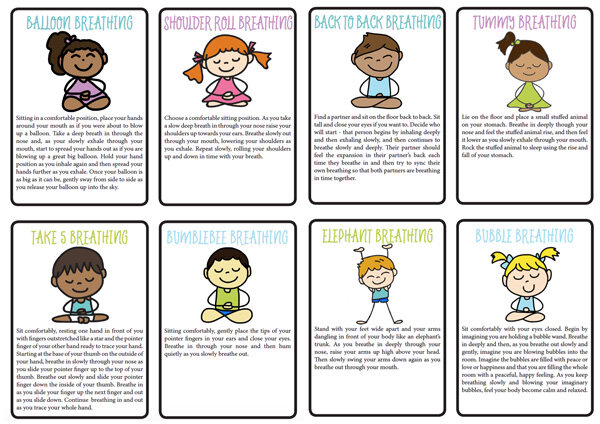5 Breathing Exercises for Your Kiddo
“Breathwork”
It is one of the handiest tools in my Managing Strong Emotions toolkit.
Our minds and bodies are interconnected making it possible for us to experience a physiological response to our emotions. Have you felt a knot in your stomach? Or your heart racing? Or starting to breathe faster as a response to your strong feelings?
It happens to kids, too.
Strong Feelings = Fight or Flight Mode
Think about what happens when our kids are anxious, angry, or worried. They go into a Fight or Flight Mode (AKA acute stress), which means suppression of the immune system, increasing susceptibility to colds and other illnesses. It also means rapid release of hormones. Then comes the shallow, quick, short breaths as less oxygen is going to their brains. This makes them tense up, their heart rate increases, blood pressure goes up, pupils dilate, and they are geared up and read to fight back. No one can think clearly in this state.
In fact, at a certain point, we actually lose access to our logical brain. It can even go as far as losing access to language and communication. Can you imagine...getting so angry that you cannot speak? #guilty
It’s not all bad though. When appropriately invoked, the stress response helps save us in dangerous circumstances. The trouble starts when tiny, little daily things constantly invoke the stress response system.
So, what do we do to get back to neutral?
Breathwork, baby!
Why does breathwork help?
Image source: OuTcomes Therapy
Deep breaths get more oxygen in our bloodstream and open up the capillaries. The result is Rest and Digest Mode. Sounds pleasant, right?
Remember, when we reach that certain point of emotional elevation, we can’t think clearly. Asking your kiddo to breathe or teach them to do so during a breakdown is a really bad idea. Instead, co-regulate with them, meaning model breathing alongside them so that their mirror neurons start to mimic what you are doing.
My advice is, don’t teach children emotional regulation techniques in the HEAT OF THE MOMENT. Teach them when they are calm when their brains are able to access logic and reason. Incorporate the techniques in their routine as brain break exercises or prior-to-sleep, relaxation exercises. Practice them as much as possible too, because repetition makes for better recall.
Benefits of breathing exercises
According to health experts at Harvard, taking deep breaths helps our bodies to calm down and mitigate the effects of acute stress.
Here are more benefits of taking long, mindful breaths:
Lowers blood pressure.
Reduces cortisol, the stress-inducing hormone.
Regulates body temperature.
Lowers heart rate.
Helps with digestion.
My mission is to help your kiddos manage big emotions, so they can stay calm then focus on their body and mind. I like having a toolbox of techniques as some may work today and the next day……zilch. Plus, kids respond to different things. You just need to know what that “thing” is.
Taking care, raising, and educating kiddos has so much trial and error. Go easy on yourself if they don’t go with your first technique. And, know that this is a process.
While it may be difficult for them to understand the concept at first, it’s usually amazing to see the impact of breathwork. One thing I’ve found VERY motivating for this type of work is explaining the science behind it all.
So, how do you do it?
Make it fun and a little bit silly. There are so many breathing techniques to use with your kiddos, but these are my fave five.
Image source: Childhood101
Bumblebee breathe
Who wouldn’t like to be Maya the Bee for a moment? Other than having a nice ring to it, I enjoy teaching it most.
Sit comfortably on the floor with your legs crossed.
Breathe through your nose for 4 seconds.
Then breathe out making a buzzing sound like a bee.
The vibration that comes from the buzzing generates a calming effect too as it activates the brainstem. You can choose to close your eyes to create a more peaceful moment.
A general rule of thumb is 7-10 breaths to calm.
You can snag a free printable from Childhood 101 to help you visualize.
You can also use other animal sounds if your kiddo doesn’t like the bee. Dragon breathe, snake or bear breathe are just a few of the animals you can imitate.
Flower breathing
You can never go wrong with nature. Most kiddos have blown away the seeds of a dandelion flower at least once. You can even use a real dandelion to teach this exercise.
Pick a flower or ask your kiddo to visualize their favorite flower.
Now breathe in deeply as you are taking in the scent of the flower.
Hold your breath for 4 seconds.
Exhale using your mouth for 4 or 5 seconds. (If it’s a dandelion, ask them to blow away the seeds as they exhale.)
And repeat.
Image source: The Calm Corner
Five finger breathing
When I am stuck in traffic and I feel like losing it, this technique has worked like magic. It’s become a go-to breathing exercise for me.
Both of you should sit comfortably on the ground or on a chair with your backs straight.
Stretch your hand and open your palm so you can see the spaces between your fingers.
Use the pointer finger of your opposite hand to trace through the open hand.
Starting from the bottom of your thumb, breathe in as you go up, and exhale as you go down.
Repeat until you get to the bottom of your pinky.
Shapes breathing
Tracing shapes while breathing is a helpful tool for your kids to have a smooth and even breathing cycle.
You can use these with a triangle, square, or rectangle (really, any shape).
Let me use my favorite to illustrate. A square.
Ask your kiddo to visualize a square. Or have it on a printout at first.
Trace one edge of the square with your finger as you breathe in. Take at least four seconds.
Pause at the corner. (Hold your breath.)
Exhale as you resume tracing the other side of the square for 4 seconds.
Repeat until you have covered the perimeter of the square.
This also works with the Figure 8 model.
Rainbow breathing
I love this one as it’s all about stretching out as you draw the rainbow across the sky. It’s a great exercise that you can incorporate during their brain break exercises.
Stand up.
Inhale as you raise your hands above your shoulders.
Hold your breath for three seconds.
Exhale as you lower your hands to your shoulder level as you draw a rainbow.
Repeat for the seven colors of the rainbow.
Balloon breathing also works the same way. Inflate and deflate the balloon as they breathe in and out, respectively.
Keep in mind that you want the kids to take deep breaths. The shallow chest breath won’t do the trick.
Taking time to do breathing exercises with your kids shows them how committed you are to their wellbeing (and yours too).
Explain to them why they are helpful and when to use them and, PRACTICE, PRACTICE, PRACTICE!
The results might surprise you.
Let me know how it goes in the comments below!
If you find yourself stuck, reach out to us or check out our coaching options.
Happy breathing, friends!
Questions? Need help? Reach out!
Email: hello@thebehaviorhub.com
Social media: @thebehaviorhub
Online school
Schedule a discovery call





